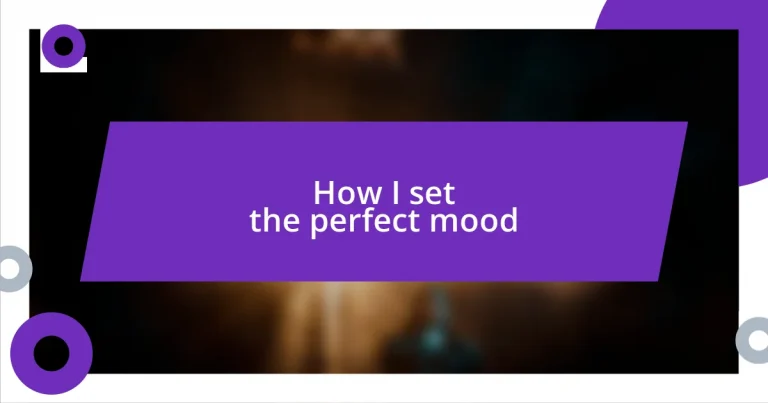Key takeaways:
- Mood is influenced by various elements such as lighting, music, scents, colors, temperature, and company, which can impact emotional states and experiences.
- Creating the right atmosphere involves thoughtful choices in lighting, color selection, and incorporating sensory elements like music and texture to enhance comfort and connection.
- Maintaining the mood requires adaptability, awareness of the environment, and occasional spontaneity to keep interactions lively and engaging.
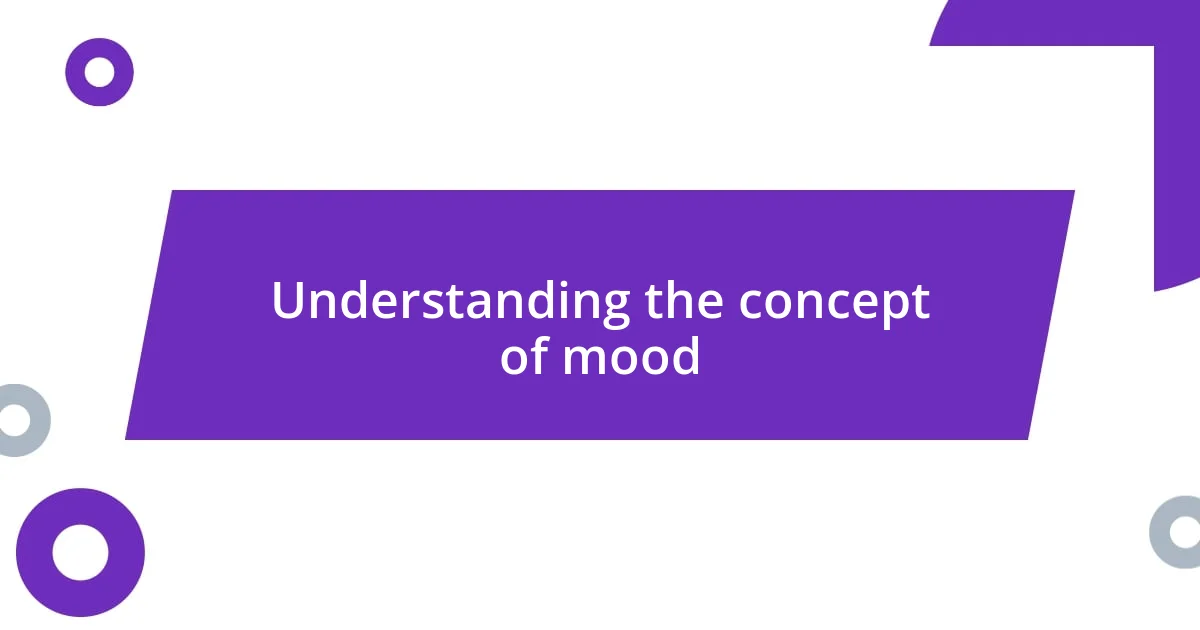
Understanding the concept of mood
Mood is a powerful element that shapes our daily experiences. I remember one rainy afternoon when I plopped down with a cup of tea, instantly transported into a cozy, reflective space. Isn’t it fascinating how external factors can shift our internal landscape so dramatically?
When I think of mood, I also consider how it intertwines with emotions and environments. For instance, after a long day, stepping into a dimly lit room filled with soft music can feel like a warm hug. How often do we overlook the simple pleasures that influence our mood?
Exploring mood goes beyond just feeling happy or sad; it’s a complex tapestry of our thoughts, surroundings, and even relationships. For example, I once attended a gathering where laughter was contagious, and that vibrant atmosphere lifted my spirits. Have you ever experienced a mood shift just by being around certain people?
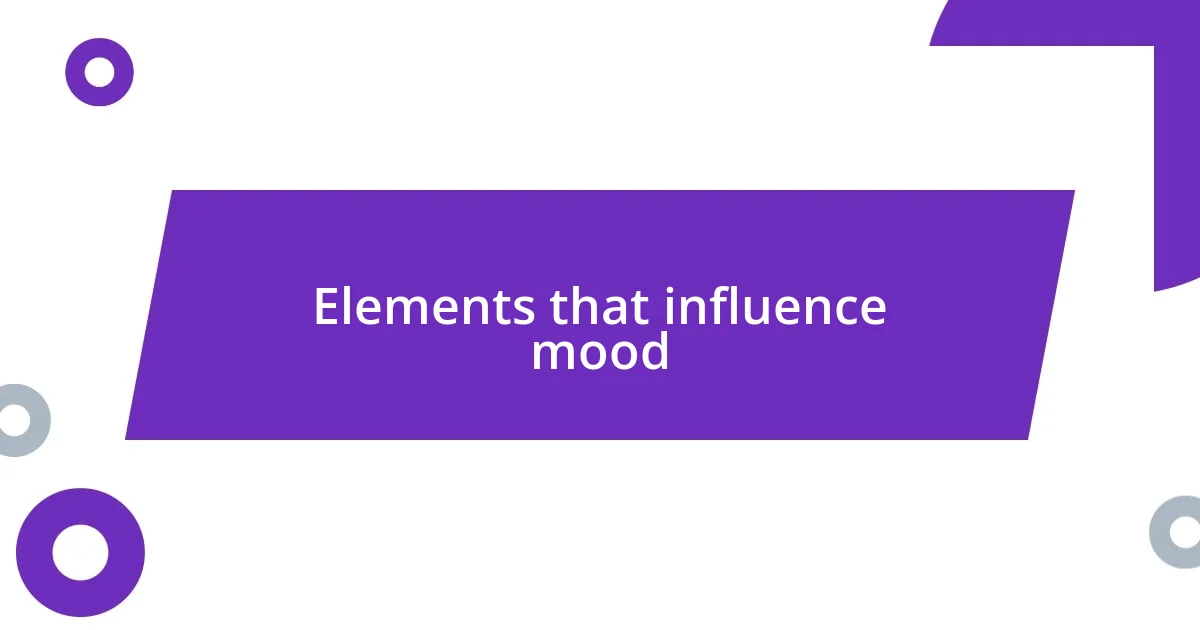
Elements that influence mood
There are several elements that can significantly influence mood, and from my experience, it often comes down to the environment and sensory experiences. For example, I remember walking into a café filled with the aroma of freshly baked pastries and the sound of soft chatter. Instantly, my spirits lifted. The simple act of being in a welcoming space made me feel energized and open to conversation.
Here are some specific elements that can impact our mood:
- Lighting: Natural light has a way of brightening our spirits, while dim lighting can create intimacy or sometimes melancholy.
- Music: Upbeat tunes can elevate energy levels, whereas slower melodies might evoke nostalgia or relaxation.
- Scents: Pleasant aromas, like lavender or citrus, can calm the mind, while unpleasant smells can trigger discomfort.
- Color: The colors around us—like vibrant yellows or calming blues—can subtly influence our emotions.
- Temperature: A comfortable climate can keep our mood light, but extremes, like heat or cold, may bring irritation.
- Company: Surrounding yourself with positive individuals can uplift your mood, while negative interactions often bring it down.
These elements combine in unique ways, creating a personalized atmosphere that either nurtures or challenges our emotional states. I’ve found that being mindful of these influences can help me intentionally set a mood that aligns with my intentions, whether it’s for relaxation or socializing.
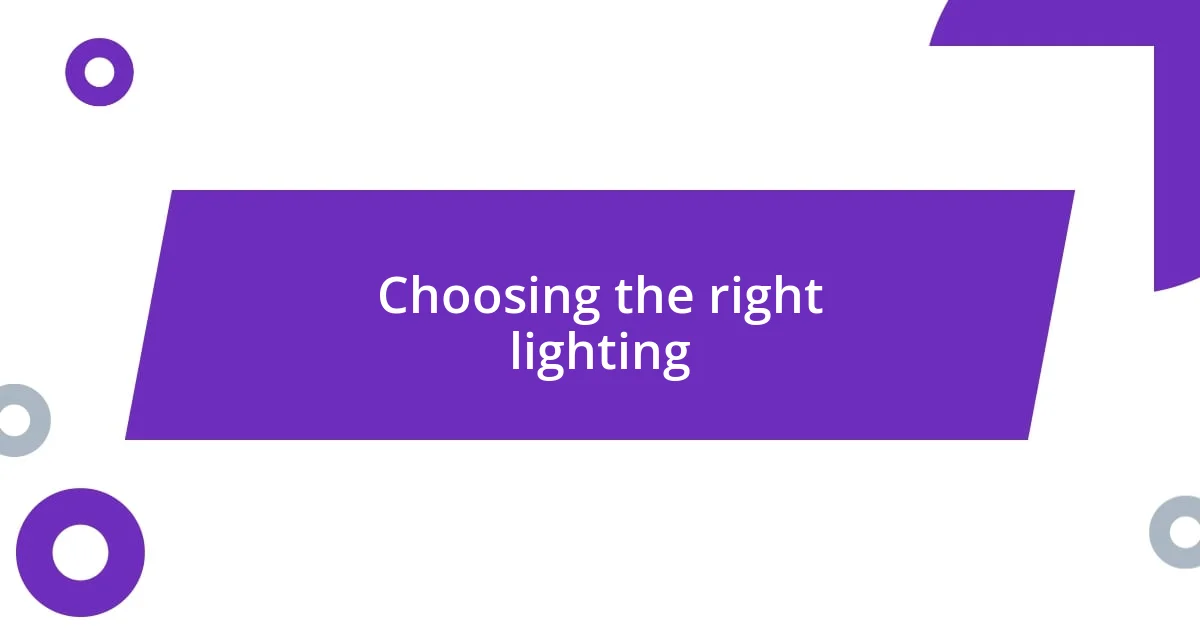
Choosing the right lighting
When it comes to choosing the right lighting, I believe it can make or break the mood of any space. Soft, warm lighting has always had a calming effect on me, drawing me into its gentle embrace. There’s something about the flicker of a candle or the glow of fairy lights that instantly elevates the environment, doesn’t it? In my experience, I’ve found that lighting can influence not only how a room looks but also how I feel within it.
In contrast, harsh, bright lights can feel jarring and even stressful. I once attended an event in a brightly lit conference room, and despite the engaging discussion, I couldn’t shake off the discomfort that came with such stark lighting. It’s interesting how these lighting choices can affect our interactions and even the depth of our conversations. Have you ever considered how the mood shifts when you dim the lights a bit? It encourages relaxation and even intimacy, making those personal connections feel more significant.
Different scenarios demand different lighting choices. For example, while preparing for a cozy movie night, I opt for dimmed lights paired with some soft lamps. This setup creates the perfect atmosphere for laughter and connection, allowing everyone to settle comfortably. On the other hand, when hosting a dinner party, I like to have a mix of light styles—some vibrant overhead lights combined with soft candlelight to make guests feel both lively and at ease. Understanding these dynamics of lighting can be the key to creating the perfect mood for any occasion.
| Lighting Type | Effect on Mood |
|---|---|
| Soft, Warm Lighting | Creates calm and intimacy, encourages relaxation. |
| Bright, Harsh Lighting | Can induce stress and discomfort, often less inviting. |
| Candlelight | Evokes warmth and coziness, perfect for intimate settings. |
| Colored Lights | Can evoke specific emotions, like blue for calm or red for excitement. |
| Natural Light | Boosts mood and energy, promotes alertness. |
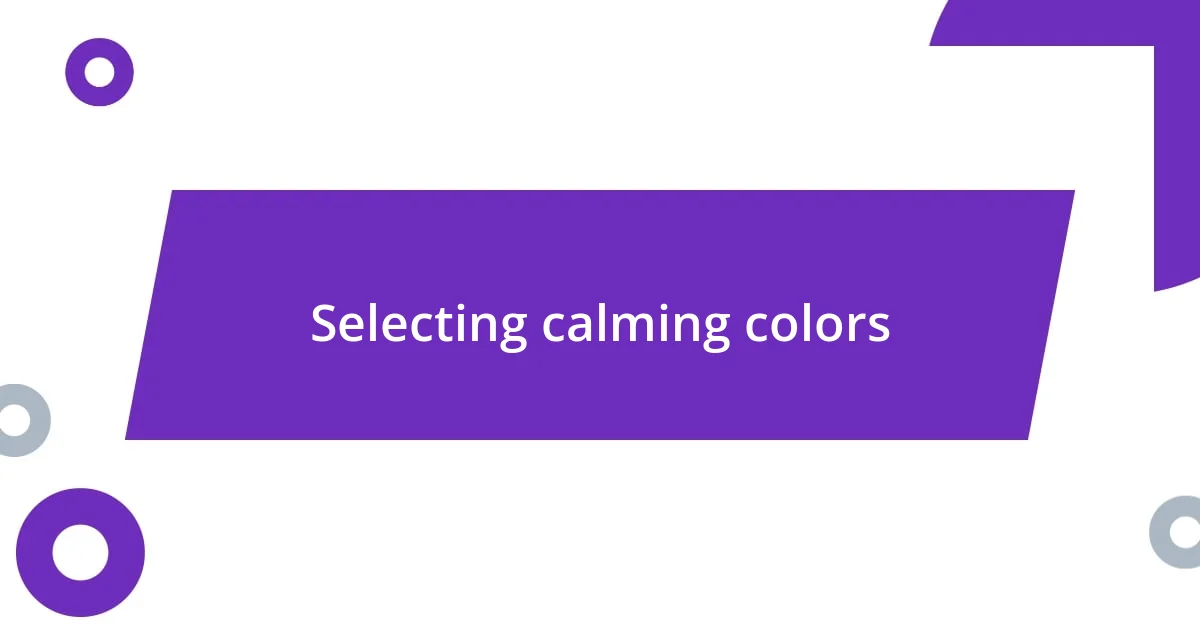
Selecting calming colors
Selecting calming colors is an art that, from my perspective, can foster a soothing atmosphere. For instance, whenever I incorporate soft blues into a room, I feel an immediate sense of tranquility envelop me. They remind me of clear skies and gentle waters, creating a serene backdrop that allows my mind to unwind. Have you ever noticed how certain shades effortlessly invite peace into a space?
In my own experiences, I’ve found that earthy tones, like muted greens and soft browns, evoke a grounding sensation. When I painted my study a subtle sage green, it transformed the area into a haven of focus and calm. This color choice was not just aesthetic; it actively supported my productivity and creativity. It’s fascinating how certain colors can influence our emotional state, isn’t it?
I also like to think about the impact of colors in our daily lives beyond just walls. For example, wearing lighter hues like peach or light lavender during stressful days has brought me comfort and optimism. Those seemingly simple choices make a positive difference in how I feel. Color is more than just decoration—it’s a powerful tool that shapes our mood and experience. What color might you select to boost your own serenity?
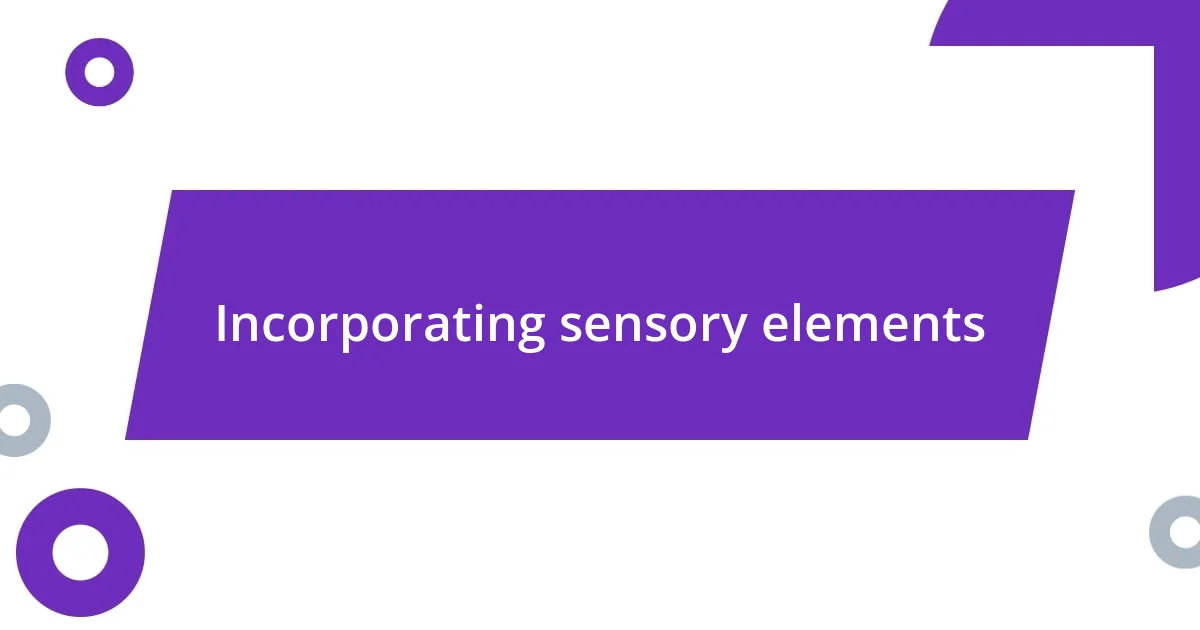
Incorporating sensory elements
Incorporating sensory elements into a space can elevate the mood immensely, especially through scent. I remember hosting a gathering where I decided to light some essential oil candles, choosing lavender for its calming properties. As soon as the fragrance filled the air, guests began to relax, their conversations flowing more naturally. Have you ever experienced how a specific scent can transport you to a memory? It’s like creating a sensory time machine, adding depth to the atmosphere.
Textures also play a crucial role in how we perceive a space. I once visited a friend’s home that featured plush cushions and soft throws. It was inviting, and I couldn’t help but sink into the comfort while we chatted. The tactile experience encouraged a sense of belonging and warmth. What do you think makes a space feel cozy? For me, it’s that blend of inviting materials that beckons you to settle in and stay awhile.
Sound is another overlooked element that can set the mood. I’ve found soothing background music to be a game changer. During a quiet dinner at home, I often choose gentle acoustic tunes that not only complement the meal but also create an effortless ambiance. Can you recall a moment when music transported you? Incorporating these auditory elements transforms the environment, making it more than just a physical space; it becomes an experience.
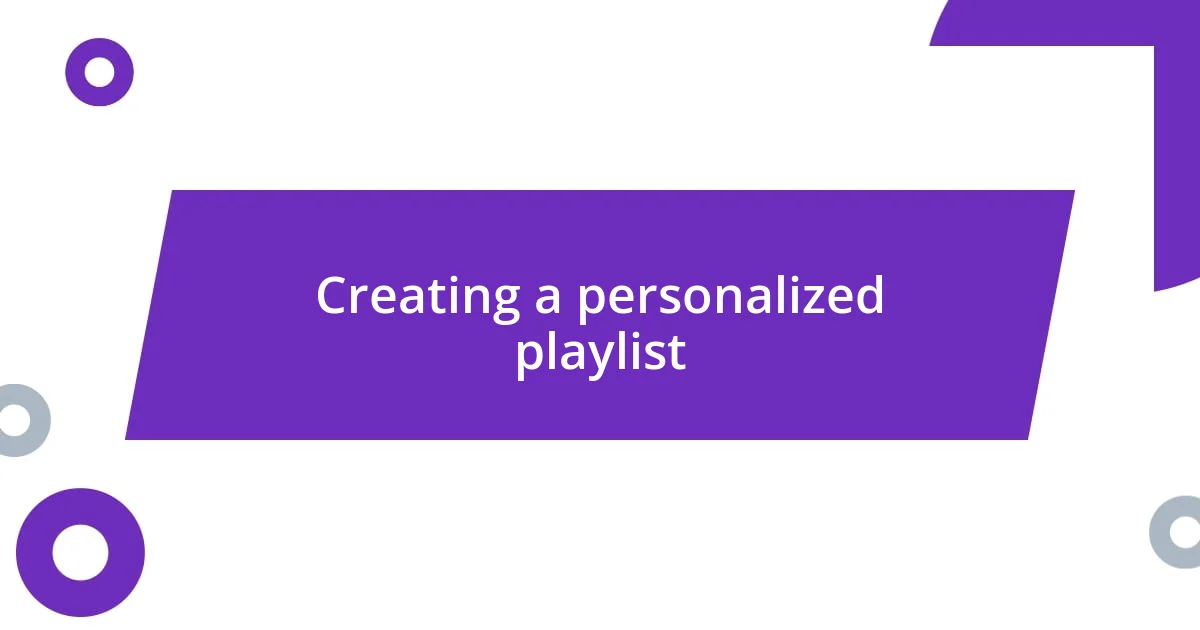
Creating a personalized playlist
Creating a personalized playlist can be one of the most enjoyable tasks when setting the perfect mood. I recall a time when I was preparing for a cozy evening at home; I curated a playlist that blended soft indie tracks with some classic jazz. Each song was chosen not just for its melody, but for how it made me feel—like each note wrapped around me in a comforting embrace. Have you ever felt your mood shift simply because of the right song?
I’ve found that including familiar favorites alongside new discoveries makes a playlist feel unique and personal. When I listened to a lesser-known artist who reminded me of my childhood, it instantly transported me to carefree summer days. This blend of nostalgia and novelty keeps the listening experience dynamic and engaging. It’s like revisiting old memories while also creating new ones—how powerful is that?
Lastly, don’t hesitate to adjust your playlist for different activities or times of day. During my morning routines, I often opt for upbeat tracks that energize me and help kickstart my day. Conversely, as evening rolls in and I unwind, I switch to softer instrumentals that lull me into relaxation. Have you experimented with mood shifts in your playlists? Tailoring your music to fit the moment can redefine your entire atmosphere, encouraging a deeper connection to your surroundings.
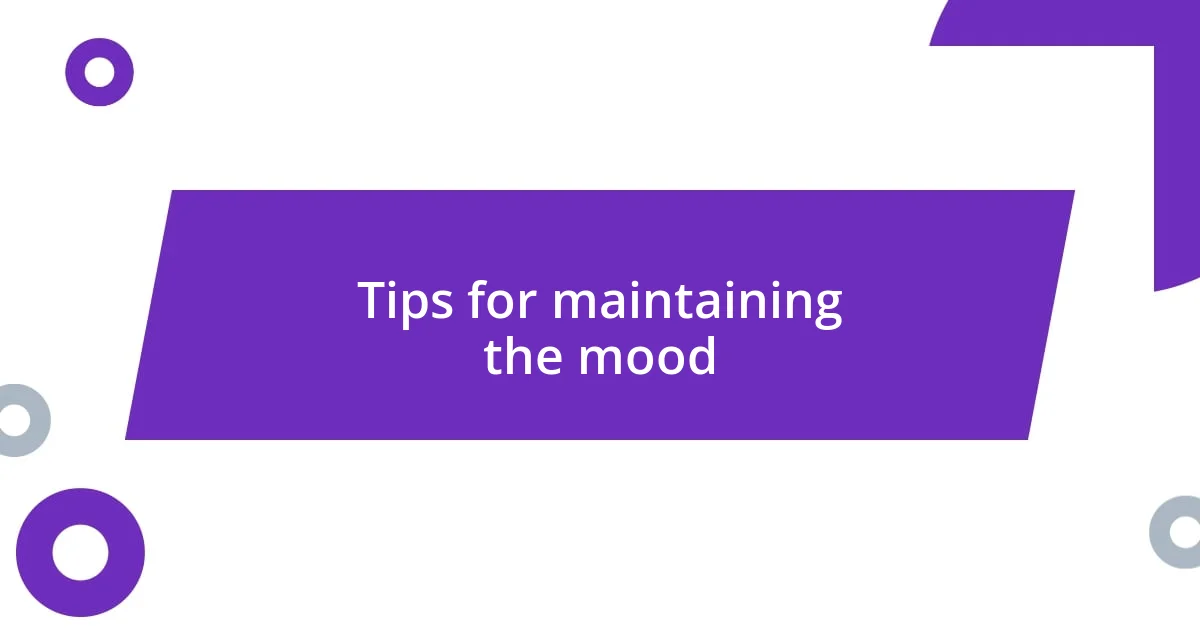
Tips for maintaining the mood
Maintaining the mood can be a delicate balancing act, but I’ve discovered that a few simple adjustments can make a significant difference. For example, I love dimming the lights as the evening progresses. When I decide to lower the brightness, it’s almost as if the room starts to breathe: it transforms from a lively gathering place into a cozy hideaway. Have you ever noticed how a little change in lighting can instantly change the vibe of a space?
Another effective strategy is to embrace spontaneity. I remember a time when some friends and I decided to turn an ordinary dinner into a themed experience by incorporating a few quirky decorations. We threw together a makeshift Italian night with checkered tablecloths and some red wine. That element of surprise not only uplifted our spirits but also fostered laughter and camaraderie. What about you—do you think a little unexpected flair can energize a gathering?
Lastly, keeping an eye on the emotional temperature of the room is key. During a recent get-together, I noticed that conversations were starting to dwindle. Instead of letting that linger, I introduced a fun game that brought everyone back together, reigniting the energy. It reminded me how essential it is to be attuned to the group’s vibe. Have you ever felt a moment like that, where a simple interactive element shifted the atmosphere? Being adaptable and responsive can truly sustain the mood you’ve created.












